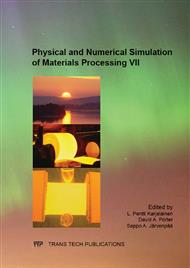p.337
p.343
p.349
p.354
p.360
p.368
p.374
p.382
p.387
Optimization of Local Laser Heat Treatment Process Using a Simple FE-Model
Abstract:
Local laser heat treatment is an efficient method to manufacture tailored heat-treated steel strips. It can be applied to soften narrow zones of the strip in order to improve its formability on desired areas. However, the properties achieved are dependent on several process parameters. An objective is to develop a predictive model to optimize the heat treatment parameters instead of using experimental trials. In the present study, a finite element model was applied to predict the maximum temperature and heating and cooling rates, as well as the heat distribution along the heat treated area. To develop the model and to test its feasibility, experiments were performed, in which process parameters were varied to study their effects on temperature distribution in a 6 mm thick abrasion resistant steel grade. Scanning of a laser beam was used to optimize the width and depth of the heat-affected zone.In practice, local laser heat treatment process parameters have to be optimized with care for successful results. The most important task is to minimize the temperature gradient between the surfaces and to keep the peak temperatures close to the austenitizing temperature. The results indicate that a simple model can be used to predict the outcome of the heat treatment, so that finite element modeling can be adopted as a suitable tool for design of local heat treatments, allowing more advanced treatments and applications with complex geometries.
Info:
Periodical:
Pages:
360-367
Citation:
Online since:
July 2013
Authors:
Keywords:
Price:
Сopyright:
© 2013 Trans Tech Publications Ltd. All Rights Reserved
Share:
Citation:


